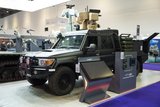Northrop Grumman demos HAMMR
Northrop Grumman successfully demonstrated its Highly Adaptable Multi-Mission Radar (HAMMR) during the US Army’s counter-rocket, artillery and mortar test at Yuma Proving Ground earlier this year, the company announced on 23 May.
The HAMMR radar is designed for situational awareness, counter-fire operations, air defence, early warning and airspace management.
During the demonstration, the radar successfully detected and identified group I and II UAS, providing real-time situational awareness to the operator. The radar also validated its ability to connect to the army’s Forward Area Air Defense command and control system, enabling the communication of information from the system back to the force.
HAMMR integrates an Active Electronically Scanned Array (AESA) fighter radar mounted on a ground vehicle or towable trailer to provide continuous 360-degree protection against multiple ground and airborne targets. The modular system includes on-board prime power and cooling, AESA and radar electronics and operator/maintainer display modules. These modules support multiple packaging concepts, making HAMMR easily adaptable to multiple vehicle types, fixed installations and C2 interfaces.
More from Digital Battlespace
-
![Babcock nears first customer for Nomad AI translation tool]()
Babcock nears first customer for Nomad AI translation tool
Nomad can provide militaries with real-time intelligence, saving critical time on the battlefield.
-
![AUSA 2025: Israel’s Asio Technologies to supply hundreds of improved Taurus tactical systems]()
AUSA 2025: Israel’s Asio Technologies to supply hundreds of improved Taurus tactical systems
Taurus operates alongside the Israel Defense Forces’ Orion system which supports mission management across tens of thousands of manoeuvring forces, from squad leaders to battalion commanders.
-
![AUSA 2025: Kopin pushes micro-LED plans as China moves faster]()
AUSA 2025: Kopin pushes micro-LED plans as China moves faster
The plan for the new displays follows fresh investment in Kopin’s European facilities by Theon and an order for head-up displays in fielded aircraft, with funding from the US Department of Defense.
-
![AUSA 2025: Persistent Systems to complete its largest order by year’s end]()
AUSA 2025: Persistent Systems to complete its largest order by year’s end
Persistent Systems received its largest ever single order for its MPU5 devices and other systems earlier this month and has already delivered the 50 units to the US Army’s 4th Infantry Division.
-
![Aselsan brings in dozens of companies and systems under the Steel Dome umbrella]()
Aselsan brings in dozens of companies and systems under the Steel Dome umbrella
Turkey has joined the family of countries attempting to establish a multilayered air defence system with government approval in August 2024 for the effort landed by Aselsan. Dubbed Steel Dome, the programme joins Israel’s Iron Dome, the US Golden Dome, India’s Mission Sudarshan Chakra and South Korea’s low-altitude missile defence system.
-
![DSEI 2025: MARSS unveils new agnostic multidomain C4 system]()
DSEI 2025: MARSS unveils new agnostic multidomain C4 system
MARSS’ NiDAR system has been deployed using sensors from static platforms to provide detection and protection for static sights, such as critical infrastructure, ports and military bases.




























